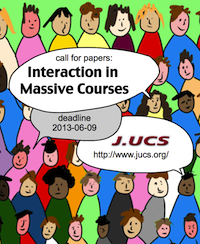 Together with my colleagues from the University of Munich I like to call for submissions on the topic „Interaction in Massive Courses„. The contributions will appear as Special Issue of the journal J.UCS (Journal of Universal Computer Science) which is an open access journal and holds an Impact Factor.
Together with my colleagues from the University of Munich I like to call for submissions on the topic „Interaction in Massive Courses„. The contributions will appear as Special Issue of the journal J.UCS (Journal of Universal Computer Science) which is an open access journal and holds an Impact Factor.
Please consider to send us a scientific contribution on 9th June 2013 at latest, if the following sounds interesting and meet you research interests as well:
The Special Issue aims to gather research works in the field of massive courses with a special focus on enhancing interaction between lecturers-students or students-student in face-to-face situations or completely online by using different kind of technologies (MOOC). For example, some few information systems created some years ago, summarized by the term Audience Response Systems (ARS). Here students are able to make votes on lecturers’ questions by using mostly special hardware (Anderson et al, 2003). Other possibilities are the use of Web 2.0 technologies (Purgathofer & Reinhard,
2008) or Social Media (Ebner, 2011) to enhance students’ engagement in live-lecturing-situations. In the last years, the above-mentioned MOOCs attracted the interest of thousands of students. Obviously this leads to new challenges on how to overcome the management of a huge number of occurring interactions and makes new strategies necessary.
Assuming that rich interactions in large groups of learners are even more critical in the development of academia this Special Issue of the Journal of Universal Computer Science is dedicated to research on media fostering interaction in massive courses.
Here you will find the detailed Call for Paper (CfP).

